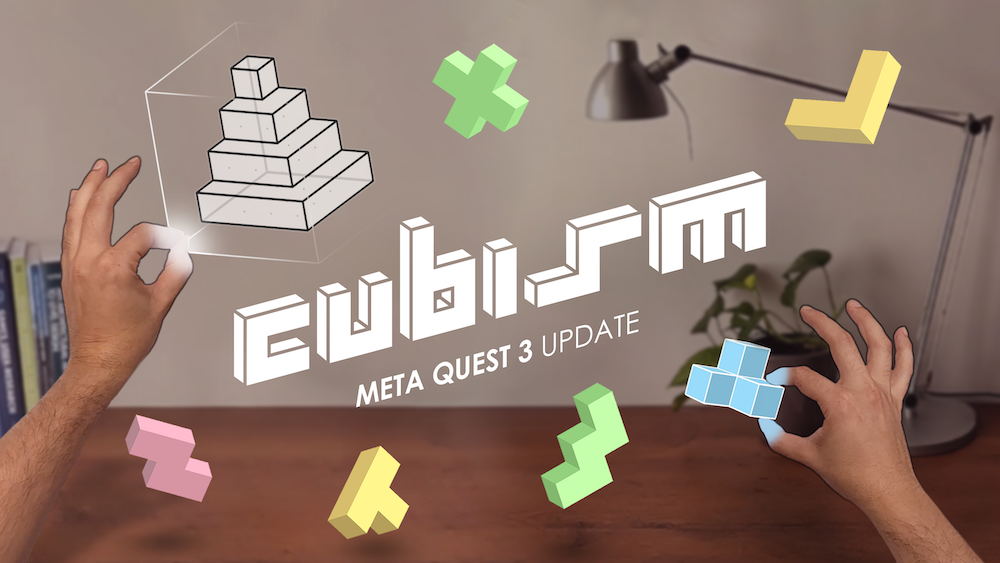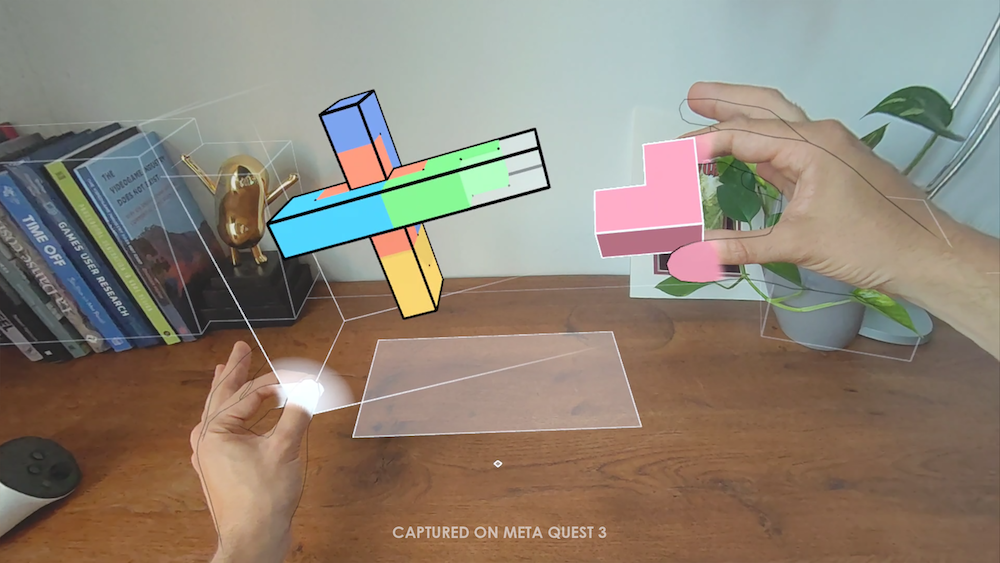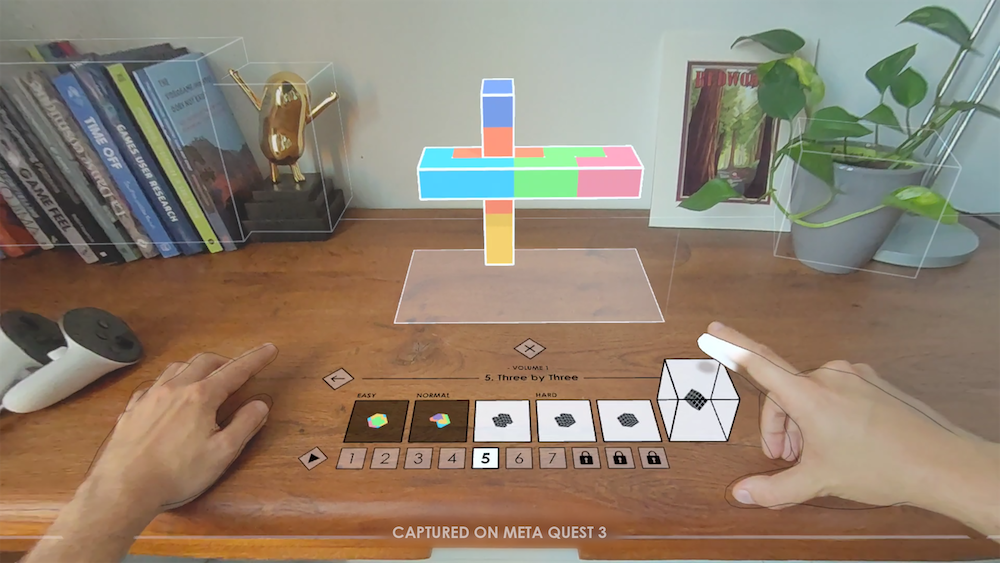Playing: Cubism
Released in 2020 Cubism is a deceptively simple puzzle game where you assemble increasingly complex shapes out of coloured blocks. It’s a bit like a 3D version of Tetris but much more meditative and relaxing as there is no timed component and all the blocks are presented at the start.
Available on Quest, Rift, Pico Neo and SteamVR the game is played in VR using controllers. However, the hand tracking and mixed reality versions were released in 2023 and are only supported on the stand-alone Meta Quest version of the game, which is the version that I have played.
The game has received loads of positive reviews over the years and currently rated 4.8 on the Meta Quest Store and Positive on Steam.
I often suggest Cubism as an introductory game for players who are new to mixed reality due to its wonderfully intuitive user experience design.
I recently replayed this game as research into design and user experience for mixed reality games and hand tracking. This article covers some of those findings.
Image source: Cubism
About the Developer
Cubism was created by solo indie developer Thomas Van Bouwel who is based in Brussels, Belgium.
If you want to know more about Bouwel and his background I recommend listening to episode #1405 of the Voices of VR podcast where he is interviewed by host Kent Bye. Bouwel has since created another mixed reality game called Laser Dance which you can wish list for the Meta Quest 3.
Design
Although I haven’t played Cubism in VR, I’ve found the mixed reality version very enjoyable. Even though the game doesn’t interact with the physical environment there’s something about playing the game within the confines of your own home which makes it feel very cosy.
Image source: Cubism
The game features a clean minimal design, which is easier said than done!
·You can play seated or standing, whatever you find more comfortable over longer periods of time.
You can play with one or both hands.
The gameplay occurs within a volumetric space or container that sits in front of you just below head height. You can even pick up the container by the corners and move it around. This is a super useful mechanic that allows you to inspect your puzzle from all angles.
In each level you are presented with an empty container and multiple coloured puzzle pieces. All pieces must be used to complete the shape.
Image source: Cubism
Onboarding
It’s important to point out that there is no text in the game except for menus. Nor is there any voiceover. Despite this, the onboarding process is very straightforward thanks to considered and intuitive design.
In the first level you are presented with a single puzzle piece and an empty container whose shape exactly resembles the puzzle piece. The only action the player can take is to interact with the puzzle piece and place it into the container. Success – you have completed the tutorial!
User Experience
The way Cubism guides and corrects the player is very subtle and intuitive. For example, you can use one hand or both at the same time which feels very natural. Your hands have a subtle grey outline but once you touch a puzzle piece, your fingertip matches that colour – providing lovely subtle visual feedback to indicate that you are interacting with that piece.
Image source: Cubism
If you pinch your fingers together you can now pick up and move that piece around. When you open your fingers you “release” that piece.
As the puzzles get more complex, it becomes difficult to see if a puzzle piece is actually “sticking out” of the container. The game overcomes this by allowing the player to pick up the whole container (by pinching the corner of the volumetric space) and inspect it from different angles. But it also alerts the player by playing a gentle chime if any pieces are protruding.
Atmosphere
It's interesting that when I first played Cubism it reminded me of Tetris. But as I progressed through the levels I felt more and more relaxed. I love playing Tetris and that manic feeling as the game gets faster and faster. But I also love playing Cubism, even though it’s a diametrically opposed experience. So what were the elements that seemed to promote this relaxed and meditative effect?
Visuals: The overall colour palette features pastel colours, simple outlines and minimal design.
Music: The music was composed by Bouwel and recorded by pianist Sahlia Wong. Again, the simplicity of the background music played by just one instrument seems to echo the “simplicity” of the game.
Audio: For those who have already played Cubism, you may not have realised but each piece has a piano note attached to it. When you solve the puzzle the notes all play a little tune. Even if players don’t notice, I suspect there’s a small part of your brain that subconsciously receives a delightful little ruffle each time it plays!
All these factors combine to place the player in a state of “flow”. Hungarian psychologist Mihaly Csikszentmihalyi coined this term to describe the state of mind a person has when they are completely immersed in a task. It is often thought to be the most ideal state as it balances effort, challenge and focus. This is so enjoyable that it becomes the basis for intrinsic motivation as the task itself is the reward.
Ergonomics
The only minor issue I have with the game is that because it was so enjoyable and immersive - I played nonstop for over an hour in one session. That’s not a particularly long session for PC games but in this game I was using my right hand predominantly and held in an upright sustained position during that whole time - I noticed that my shoulder and elbow were sore later that day. Perhaps a small improvement could be an early recommendation to take frequent breaks or at least stretch once in a while.
Check out the trailer for Cubism below or visit the website here.




